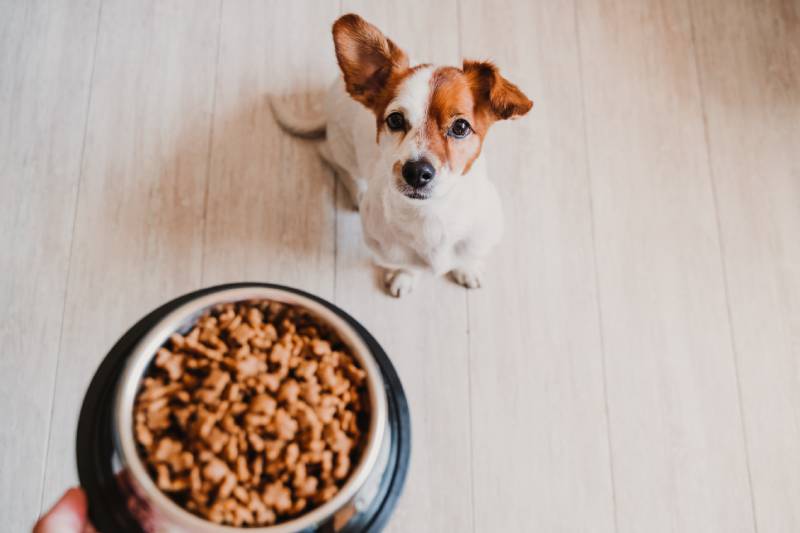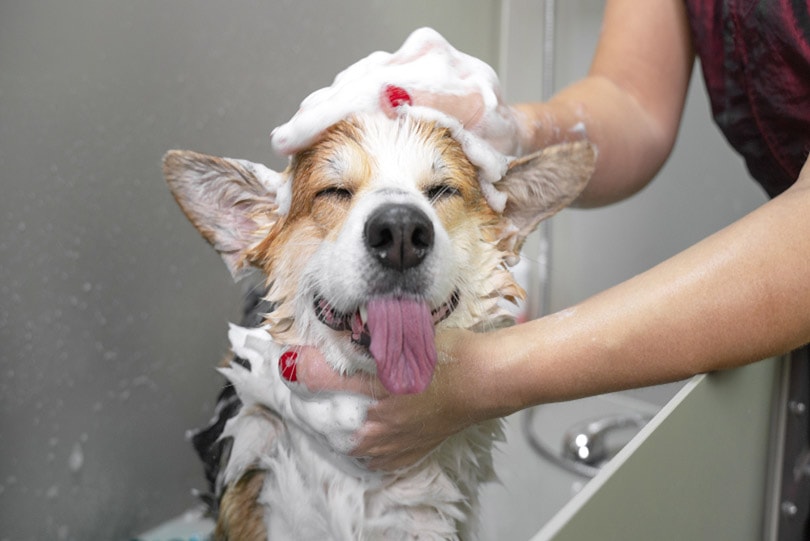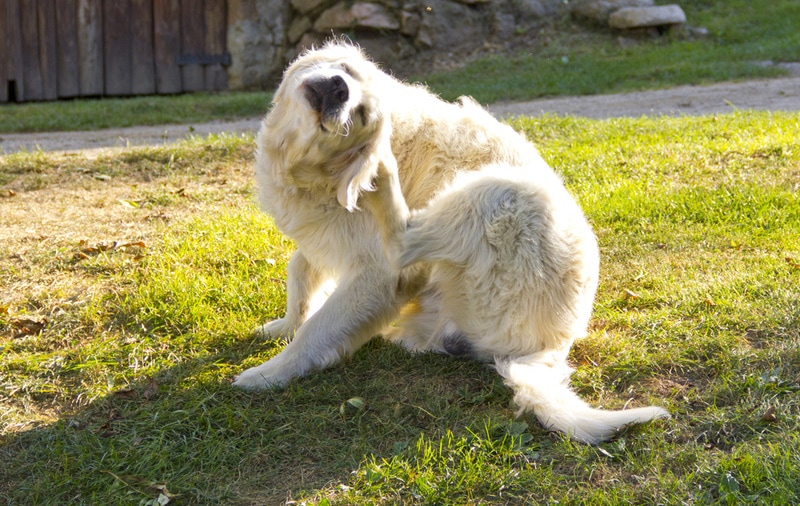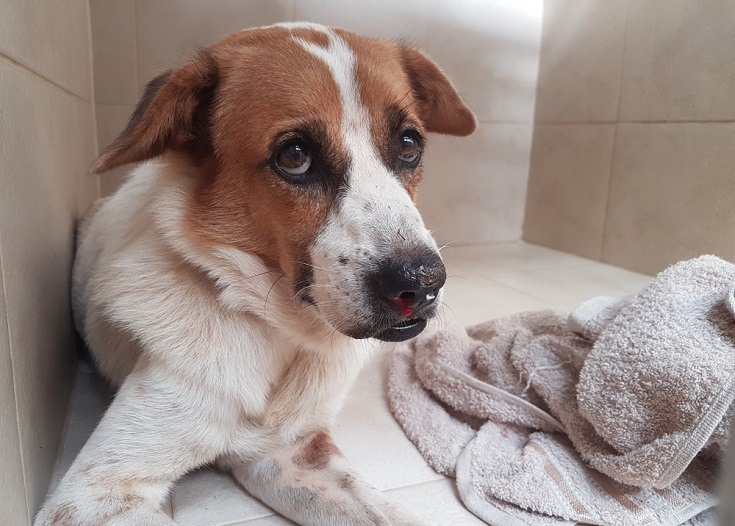What to Feed a Dog With a Yeast Infection: Vet-Reviewed Guide
By Ashley Bates
Updated on

Click to Skip Ahead
If you have recently discovered that your dog has a yeast infection on their skin, between their toes, in their ears or all over, you want to work diligently to get them on the road to recovery. Yeast and bacterial infections of the skin are almost always secondary problems that have been allowed to take over due to a primary disease process or breed conformation. For example, a Shar-pei with deep set skin folds will be much more prone to yeast infections than a dog without skin folds, because yeasts thrive in warm, moist environments. Diseases that alter an animal’s skin defense such as Cushing’s disease, parasitic infestations and allergies, predispose an animal to yeast and bacterial skin infections.
In this article, we’re going to discuss some different ways you can enhance your dog’s diet to improve the skin’s barrier to infection through diet and supplementation. Dog’s with yeast infections will require veterinary assistance to diagnose the primary problem, treat the yeast infection and make a plan to prevent the infection from returning.
Ask Your Vet
Before trying to feed your dog something different to treat a yeast infection, make an appointment with your veterinarian. As a yeast infection is secondary to another problem, having your vet on board will help you, and especially help your dog.
Your dog could be getting a yeast infection for a variety of reasons, and they will require more than just over the counter or at-home treatments. It is imperative to get to the bottom of the problem so you can solve it once and for all.
While we mean to give you valuable information and suggestions, always clear any dietary changes and supplements with the medical professional who knows your dog best.

What to Feed a Dog with a Yeast Infection
If you have already spoken with your vet and you’re looking for supplements that could help improve your dog’s skin barrier and reduce the likelihood of a repeat infection, we have a few suggestions.
Prescription Dog Food
Yeast infections of the skin, feet or the ears are almost always secondary to an underlying problem. This primary problem is what has allowed a yeast infection to take hold and could be any number of things. One of the most common primary issues that predisposes a dog to a yeast infection are allergies, either to the environment or their food.
If your vet suspects a food allergy as the primary cause, they will likely advise that you buy a prescription dog food. They might want to try a specific brand or ingredient to see if it helps with the underlying allergy, and thus reduces the likelihood of the yeast infection recurring. Alternatively, they may recommend a hydrolyzed diet, where the proteins have been blitzed to such a small size that they essentially become “invisible” to your dog’s immune system. Often, food trials can be taxing and long, but they are the best way of diagnosing a food allergy.
So, if you are trying your first prescription diet, remember that it won’t work overnight, and that a food trial will take between 8-10 weeks to complete. Prescription diets can also be pricey, so be careful to follow your vet’s advice when picking the right one.

Essential Fatty Acids (EFAs)
There is a lot of research that has gone into finding supplements that help maintain the health of a dog’s skin. This is particularly important when it comes to multi-modal management of dogs with allergic skin disease. Essential fatty acids are just that; essential nutrients that must be provided through an animal’s diet as they cannot be synthesized within the body.
- Improving the barrier function of the skin and thus reducing transepidermal water loss and microbe/allergen entry
- Modulating inflammatory pathways, reducing itching and thus reducing self-trauma to the skin layer.
Effective skin supplements are hugely useful in the management of allergic dogs, and should contain both omega-3 and omega-6. The sources of the EFAs used in veterinary supplements on the market varies greatly.
What else can I do to help my dog’s skin?
1. Complete the course prescribed
Once your vet has diagnosed the primary problem and given you medication to use on your dog’s skin, ensure you finish the course prescribed (be it an anti-fungal, ear drops, medicated shampoo etc) and ensure you visit your vet at the end of the course to ensure the infection has gone. Your vet will take a sample from the affected area of skin (usually with a cotton bud) and have a look under the microscope to ensure the infection has gone.

2. Prevent swimming
Dogs that love the water can be particularly prone to yeast infections in their ears, due to the constant warm and wet environment that is created. If you can’t stop your dog from swimming, use an appropriate ear cleaner in both ears after the swimming event.
3. Ongoing management of your dog’s condition
This depends on the primary diagnosis, but if your dog has been diagnosed with a systemic problem that has predisposed it to yeast infections, make sure you follow the advice of the vet and keep up with your dog’s medications and check ups.
Keeping on top of parasite preventatives can reduce self-trauma, and therefore reduce the chance of another yeast infection.
Avoiding known allergens such as freshly cut grass or very dusty places can help to reduce your dog’s itchiness, and therefore reduces self-trauma.
Regular cleaning of any skin folds and ears can help reduce the build up of yeasts, especially during the warmer months or after swimming.
What Causes Yeast Infections in Dogs?
There can be many different causes of a yeast infection in dogs, ranging from allergies, systemic disease processes, anatomy, conformation and parasitic infections.
In order to understand how to combat a yeast infection in your dog, it is important to know what the primary cause is first. For this, you will need to visit your vet to start investigations.

What Are the Signs of Yeast Infections in Dogs?
Usually, you will notice the signs of a yeast infection quite quickly, due to its classic, sweet and beer-like odor. Yeast infections are most common in a dog’s ear canals, between its toes, or within skin folds.
Here are the usual signs of yeast infections in dogs, depending on the area infected:
Ears:
- Obsessively scratching ears
- Shaking head
- Classic odor
- Brown, yellow or bloody discharge from the ear
- Crusting on the inner part of the pinna (ear flap)
- Redness of ear canal

Paws:
- Obsessive licking and chewing feet
- Yellow saliva staining to hair around the paws
- Pinkness to the skin between the pads on the feet
- Brown discharge in nail beds
Skin (particularly skin folds):
- Intense itching
- Darker skin color
- Musty odor
- Flaky, greasy or crusty skin
- Red, irritated and inflamed skin
Which Dogs Are Most Susceptible to Yeast Infections?
Dogs with food and environmental allergies are highly susceptible to yeast infections, due to their poor skin barrier which allows allergens and pathogens in.
Certain breeds, such as British Bulldogs, Shar-Peis and French Bulldogs are prone to yeast infections of their skin folds, known as skin fold dermatitis. Breeds with long, droopy ears such as Cocker Spaniels and Labradors are more prone to yeasty ear infections.

How Are Yeast Infections Treated?
Treating a dog for a yeast infection will greatly depend on the signs that they are displaying. There are a wide variety of treatments for yeast infections, including topical antifungal creams, sprays, medicated shampoos, and wipes. If the infection requires continual topical management, your veterinarian might prescribe chlorhexidine or miconazole based shampoos.
If the yeast infection is proving very difficult to treat or is very widespread, your vet might prescribe antifungal medications by mouth. Ultimately, the goal is to relieve your pet’s discomfort and prevent yeast infections in the future. So, discovering the underlying reason why your dog is getting yeast infections is a good way to prevent them.
Is a Yeast Infection Life-Threatening?
A yeast infection on its own is not a fatal problem. However, if a yeast infection is left untreated for a long time, it can lead to complications. If a yeast infection spreads, it can cover the entire body and is very painful and uncomfortable. Because a yeast infection causes so much skin irritation, dogs commonly also develop a bacterial infection on top of the primary infection.

Is a Yeast Infection Contagious?
A yeast infection is not contagious. Therefore, if your dog develops a yeast infection, they did not get it from another dog or animal. Yeast infections occur due to a buildup of yeast on the skin that grows out of control.
How Can You Prevent Yeast Infections for Dogs?
The only way to prevent recurring yeast infections is to uncover the reason your dog is getting them in the first place.
Typically, there is a defined underlying reason for recurring yeast infections, such as allergies and other systemic conditions. Until the underlying problem is controlled, yeast infections will likely continue to be a problem for your dog.
It is important to work alongside your veterinarian at this time. You will likely have to go through a few tests and trials before uncovering the problem but a correct diagnosis can help to reduce or prevent the occurrence of future infections.
Conclusion
So now you know the basics of managing yeast infections, and hopefully feel more knowledgeable about the process of finding out what is causing them to occur and reoccur in your furry friend. Keep in mind, this article is not a substitute for professional guidance. Always ask your vet before making any changes to your dog’s diet.
With any luck, you understand yeast infections in dogs just a little bit better, and hopefully, you can get your itchy pal on the path to better health.
Featured Image Credit: Kobkik, Shutterstock














